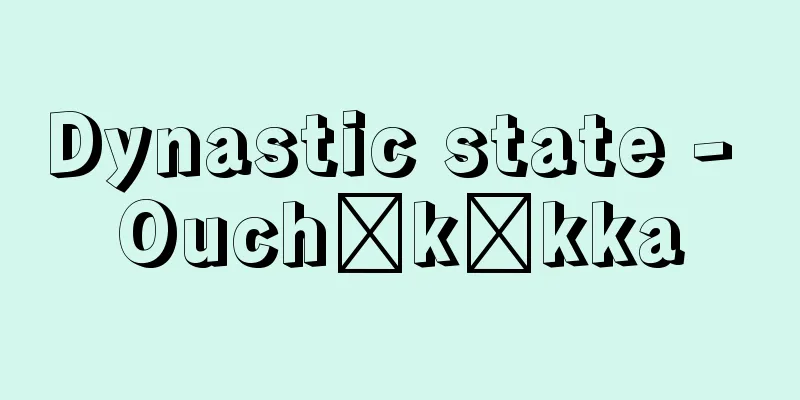Dynastic state - Ouchōkōkka

|
This term indicates the state of state rule from the 10th to 12th centuries, the period leading up to the medieval state after the collapse of the Ritsuryo state. The Ritsuryo state rule had reached a deadlock by the beginning of the 10th century, and there was hesitation in calling the state rule of about 300 years until the end of the 12th century when the Kamakura Shogunate was established a Ritsuryo state. In 1956, Takao Kazuhiko used the term "dynastic state," but in 1958, Toda Yoshimi conceptualized the term "dynastic state" as a state between the Ritsuryo state and the medieval state. From the beginning of the 10th century, when the principle of individual personal rule, which was the basis of the Ritsuryo state rule, was abandoned and a tax system based on levies on fields was introduced, Ritsuryo rule changed under the control of kokushi in each province. It is no longer appropriate to call it a Ritsuryo state. The Ritsuryo system continued to exist within the Imperial Court even after that, but if we talk about the state of the Imperial Court, the Ritsuryo system also remained in place during the Middle Ages and early modern times. The concept of a dynastic state was established based on the state of affairs under the rule of kokushi (provincial governors) in various provinces. There is virtually no disagreement that the dynastic state began in the early 10th century, but there are two theories regarding the lower limit: one that places it up to the mid-11th century, and the other that places it up to the establishment of the Kamakura Shogunate at the end of the 12th century. The lower limit is set differently depending on how one interprets the beginning of the Middle Ages. The theory that places it up to the end of the 12th century stops at the 40s of the 11th century, separating the early and late dynastic states. The concept of a dynastic state, established from the system of national control, is presented from a different perspective than the period divisions of the Sekkan period and the Insei period that have been traditionally considered in political history, but there are many changes in national politics that have been considered in terms of the Sekkan period and the Insei period that should be reconsidered from the perspective of a dynastic state. [Sakamoto Prize 3] "The Japanese Dynastic State System" by Sakamoto Shozo (1972, University of Tokyo Press)" ▽ "The History of Japan 6: The Sekkan Period" by Sakamoto Shozo (1974, Shogakukan) Source: Shogakukan Encyclopedia Nipponica About Encyclopedia Nipponica Information | Legend |
|
律令(りつりょう)国家が崩壊したあと、中世国家に至るまでの時期、10~12世紀の国家支配のあり方を示す用語。律令国家支配は10世紀に入るころには行き詰まっており、鎌倉幕府が成立する12世紀末までの約300年間の国家支配を、律令国家と称することは躊躇(ちゅうちょ)されていた。1956年(昭和31)高尾一彦が王朝国家という用語を使ったが、58年戸田芳実(よしみ)が王朝国家という用語を、律令国家から中世国家に至る間の国家として概念づけた。律令国家支配の基本であった個別人身支配原則が放棄されて、田地に対する賦課(ふか)を基本とする税制体系へ転換した10世紀初頭から、諸国の国司の支配下において律令制支配は変化した。もはや律令国家とよぶのは適当でない。朝廷内部ではその後も律令の制度が残存していたが、そのような朝廷のあり方をいうならば、中世や近世にも律令の制度が残存していた。王朝国家とは、諸国で国司の支配下のあり方からたてられた概念である。 王朝国家が10世紀初頭に始まることはほぼ異論がないが、下限については、11世紀中期までとする説と、12世紀末の鎌倉幕府成立までとする説とがある。それは、中世の開始をどのように解するかで下限の設定を異にするのである。12世紀末までとする説では、11世紀40年代でくぎって、前期王朝国家と後期王朝国家とする。国家支配体制からたてられた王朝国家概念は、従来の政治史からいわれた摂関(せっかん)時代、院政時代という時代区分とは異なる視角から提起されたものだが、摂関時代、院政時代という時代区分から考えられてきた国政の変化などは、王朝国家の観点から再検討されるべきものが少なくない。 [坂本賞三] 『坂本賞三著『日本王朝国家体制論』(1972・東京大学出版会)』▽『坂本賞三著『日本の歴史6 摂関時代』(1974・小学館)』 出典 小学館 日本大百科全書(ニッポニカ)日本大百科全書(ニッポニカ)について 情報 | 凡例 |
<<: Yellow feldspar - melilite
Recommend
Azumi Isora - Azumi no Isora
An ancient sea spirit. In the miraculous record &q...
Politician - Seijika
A person who engages in political activities. Poli...
Indian Independence League
…An organization that cooperated with the Japanes...
Provisional payment - Karinoufu
...All of these effects arise according to the co...
osculating circle
…Depending on whether κ is positive or negative, ...
Industrial accounting - kougyouboki
It is a type of applied bookkeeping applied to in...
Ajita Kesakambalin
One of the Indian free thinkers active during the ...
Whooping cough - pertussis
It is an acute infectious disease of the respirat...
Palaiyakkaran (English notation) Palaiyakkaran
...Especially in the second half of the 16th cent...
Short wave - tanpa (English spelling) short wave
One of the names given to classify radio waves ac...
Chain stitching
...There are also funerary tents and awnings made...
Smelser, NJ (English spelling) SmelserNJ
…(4) Research on collective behavior and social c...
Muhāsibi (English spelling) ārith b. Asad al-Muhāsibi
An early Sufi (Islamic mystic). Born in Basra, he...
Blackstonia perfoliata (English spelling)
...Many species have beautiful flowers, and many ...
Cooksonia
…Some scholars believe that the larger Mayor spec...









